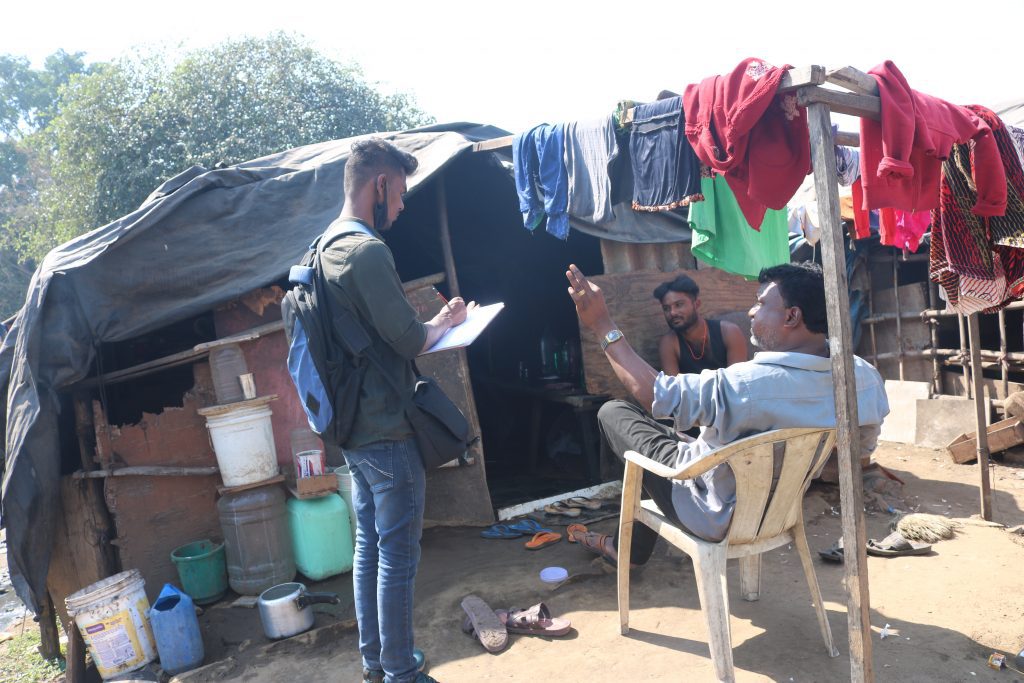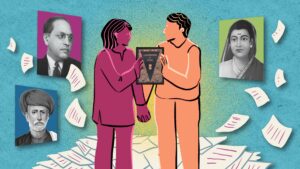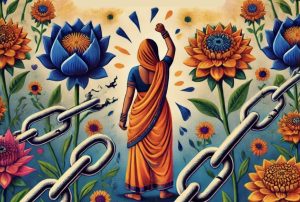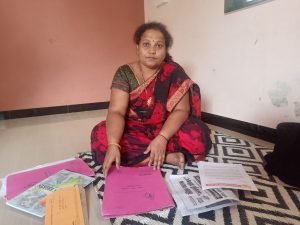‘Over 80% Of Nomadic Homes Have No Toilets, 70% None Near Them’
- Deepa Pawar

With no attention paid to their sanitation needs, India’s nomadic communities are forced to either defecate in the open or struggle for access to unsafe and filthy public toilets, shows a recent study. And it is the women and girls of these communities who face the brunt of this crisis, routinely risking sexual harassment and violence at these facilities.
The survey was conducted among the nomadic settlements of Thane district in Maharashtra between January and May 2022 by Anubhuti, an organisation focussed on the rights of India’s nomadic tribes and denotified tribes (NT-DNTs).
Over 80% of those interviewed for the study said they do not have toilets at home and 70% had none anywhere near their settlement, forcing 50% to defecate in the open. Upto 55% said they found public toilets unsafe. Female respondents said they had no choice but to ask someone to accompany them to the toilet at night.
“We are forced to resort to open defecation, especially at night when public toilets are closed or too far away. Our tents are in the middle of many buildings nearby and men from these buildings can easily watch us. Boys and young men hide in the bushes around and watch and harass us and our girls when they go to relieve themselves,” said a woman who lives in a tent settlement of 25 families of the Portraj community in Manda, Titwala, 55 km from Mumbai. Nomadic family groups move to this open ground at the same time every year for a few months to perform the traditional Potraj dance and seek alms.
Nomadic communities everywhere in India are vilified and marginalised because of the “criminal” tag attached to them by the British colonial regime under the Criminal Tribes Act of 1871. Behanbox is marking Vimukt Divas (August 31), the day India’s nomadic communities were officially rid of this tag in 1952, with a two-part series by this author, herself from the Ghisadi (Gadiya Lohar) community of ironsmiths.
The first of the series was a first-hand narrative of the daily indignities suffered by these communities who live mostly in tent settlements and engaged in highly informal work. This work includes folk art performances, acrobatics, crafting of iron tools and weapons, working with soil and stones, selling assorted wares and offering repair services door-to-door.
In this, the second part of the series, we report the findings of a study on the lack of sanitation facilities for these tribes.
The Anubhuti study was conducted by the members of the community themselves to ensure that the narrative was not controlled and manipulated by outsiders. Upto eight youth leaders, in collaboration with 15 community leaders, covered 22 pockets across Thane district in Maharashtra, and audited 28 toilets using 209 personal interviews.
Method for the study

We used mixed-method research for the study with tools like audit, participant observation, and in-depth interviews. The whole process including conceptualisation, research design, training, data collection, data analysis and subsequent advocacy was led by leaders, women and youth of NT-DNT communities.
The process began with a full-day research training workshop for the youth of NT-DNTs and other Bahujan communities. They then formed the research team representing different lived realities – of a girl, a young woman, young mother, informal sector worker and so on.
The training process included understanding intersections of nomadic and criminalised status with caste, gender, sexuality, disability, religion and citizenship in context of sanitation; finalisation of data collection tools; understanding ethics of human rights-based participatory methodology; logistical planning for data collection keeping in mind these ethics; and connection of the research team with community leaders.
The next step was the mapping of diverse NT-DNT settlements in the broader research area of Thane district so as to get rich data representing differences within nomadic families. This was followed by the identification of the community and the public toilets where available near NT-DNT settlements, and mobilisation of participants for the interviews. These participants were identified keeping in mind diverse representation — children, girls, women, the old, with disabilities, of different religions, working different occupations, trans persons, families living in tents, families living in rented rooms in slums, families living on the road side and so on.
Finally, there was actual data collection and analysis. The communities who participated included the Nathpanthi Davri Gosavi (begging), Gadiya Lohar Ghisadi (ironsmiths), Vaidu (healers), Banjara (folk performers), Vadari (stone and soil workers), Vaghya Murali (religious performers), Gopal (work with cattle) and Potraj (roadshow performers). While most continue with these traditional occupations, given the dwindling demand and payment for this work, some also take up other livelihoods such as construction, daily wage labour etc.
Here is what we found in our interviews.
Caste and sanitation
Most sanitation workers and cleaners in India are from Bahujan castes, including Dalits and DNTs. The very natural human act of relieving oneself is closely related with notions of impurity deeply embedded in India’s caste system. Nomadic populations are thus considered “too dirty” to use public toilets and are treated with hostility by toilet attendants and other users. These communities are easily identifiable by their clothes, which are often not “clean” or “proper” because they engage in heavy physical labour.
“Our Potraj women and men are very hardworking, they dance on the roads and ask for alms in return. They wear their costumes and carry their drums when working. Do you think they are welcomed when they try to use a toilet? Instead they face humiliation and ridicule, made to feel like they are too dirty to even use a toilet,” a community leader said.
Another incident highlighted the casteist lens with which these communities are viewed. The mukadam (supervisor) of one brick kiln, where entire families live in mud houses and work all day, told our researchers this: “It is true there is no toilet in this settlement, but they are anyway not used to using toilets [implying that they are not civilised enough to do so]. They are used to going in the open so we don’t ask for any to be built.” A majority of respondents told us they face this kind of response from administrations too.
This attitude also ignores the sexual violence regularly faced by women and children in brick kilns and reports of rape threats doubling for women who use open defecation sites.
Toilets unsafe, say 34%
Sanitation is also closely connected with gender-related issues of shame, privacy, bodily dignity, safety, and body politics. The worst of sexual harassment, rape and other attacks on women, girls and trans persons from the community are reported when they venture out to use public toilets or open defecation sites at night.
A 2015 Bombay High Court observation took note of the unsafe, dirty, facilities-less public toilets in a petition. Many studies have reported that women end up holding their urge to ease themselves and not drink enough water once they leave home because there are few clean public toilets. However, these are stories of women who are privileged enough to have toilets at home. In the case of nomadic families, there are no homes, leave aside indoor toilets. The reality of NT-DNT transwomen is even worse.
Only one of the 28 toilets audited had a separate toilet block for trans persons. The survey findings show several safety issues faced by women, trans persons, persons with disability, the aged and children. Upto 34% respondents said that the toilets are unsafe at night and 23% said that these are situated in places prone to snakes and scorpions. This is especially dangerous at night and when there are no lights.
At least 15% respondents said that there are no separate toilet blocks for men and women. Several responses pointed to the absence of lockless or broken doors or no door at all. A sizable number also pointed out that the structures are very dilapidated and especially not safe for children, the aged and persons with disability.
A builder owns the land on which the Portraj community drops anchor every year in Manda, Titwala. He allows them to live there temporarily in tents for a fee. But they have no access to water, electricity or other facilities and they have to buy everything for a high fee from nearby buildings.
One of the women told us of the threats to the safety of women and children at the site. “A 14-year-old girl who could not find anyone to accompany her when she went to relieve herself, was caught by some men and somehow saved herself and ran back. This is what our daughters have to face daily,” she said.
‘Kaccha homes, kacha lives’
Being nomadic means facing a very different reality. There is little understanding of this reality among development planners, this author has observed over years of work. While she was researching on the sexual reproductive health rights of NT-DNT women in Maharashtra , many women spoke to her about the very kaccha (unstructured, raw, precarious) nature of their existence. This experience rose out of the history of criminalisation and persecution faced by NT-DNT communities.
Their homes are nothing more than tents with no walls or doors. Every time they need to change sanitary pads or to wash themselves, they have to pay to use a public toilet. And there, they are often accused by toilet attendants and other users of dirtying the facility without any proof of guilt other than their clothes, usually soiled over days of hard outdoor labour.
Some of the problematic issues that respondents listed in the use of public toilets included small children being unable to use facilities built for adults and even instances of them falling into the pot.
No facilities for the disabled
Disabled persons complained about having to drag themselves across dirty floors – only one toilet among all audited was disabled friendly.
“There are no railings or separate toilets for people like me so I have to drag my body across the dirty toilet floor. I would rather die than face this nightmare daily,” said an elderly nomadic woman with impaired mobility. “The boy accompanying me to the toilet is growing up now and it feels shameful [to seek his help]. But I have no other option.”
It was also alleged that toilet attendants in public places like markets did not allow members of nomadic communities to access the facility; those who were forced to defecate in the open were loudly insulted by security guards of nearby buildings.
Most toilets were reported to be closed at night, and during the day, they were filthy – almost 42% said toilets had no water, light or dustbin in the toilets. A good 11% complained of finding scorpions and snakes in toilets.
In one instance, the research team found that women living and working in brick kilns had to walk several kilometres to a water tap, pay Rs. 2 per pot, and carry several back while crossing dangerous highways. This was the settlement’s only source of water, so one can only imagine how little of it was available for sanitation needs.
Several women and men living in a tent settlement of over 530 families of Nathpanthi Davri Gosavi, Banjara, Pardhi, Potraj, Mariyawale and other nomadic communities shared their problems with the research team.
“There is a public toilet right at the entrance to our basti,” a man said. “The sewage water filled with faeces flows out from behind the toilet directly into our homes. Our homes don’t have floors because the tents are built directly on the ground. So we have to live with this water directly in our homes. Especially in the rains, when this dirty water mixes with the rain water and flows freely into the basti, it is impossible to live there. We have to leave our homes to go and live on upper land for some time.”
Criminalisation and sanitation
Despite being decriminalised, NT-DNTs continue to be seen with suspicion by both, the rest of society as well as the administration.
“Not only are we harassed when we are forced to go in the open, but people specially come to throw stones at us as if we are animals. Many women have been hit and injured on the head and other body parts. You cannot imagine the fear and humiliation of being rained on by stones when we are trying to take care of something as private as this,” said one woman in a tent settlement of about 150 families of the Nathpanthi Davari Gosavi and Muslim nomadic tribes on the outskirts of Bhiwandi in Kalyan.
Other women agreed, adding that the Muslim nomadic women among them face this hostility even more than the Nathpanthi women, pointing to a likely added layer of marginalisation.
This violation of human rights and dignity, inhuman attitudes, lack of toilet structures and access was observable not only in case studies and findings, but at every step of our research and data collection. It leads to acute irritation, frustration, stress, and anxiety among those who deal with it, our researchers found. The impact of substandard or absent sanitation on a community’s mental health makes a strong case for change.
Room for change
As we said in the first part of this series, in mainstream research, data generation remains in the hands of a few who are inevitably privileged by caste, class and to some extent by gender, and who have access to higher education, libraries, universities and research theories. But the community supplying the data is left without any agency over how it is gathered, represented, or used. This research instead has developed a community-led model for ground-driven data generation, fact-finding and advocacy which challenges mainstream narratives.
Based on these interactions, Anubhuti formulated several recommendations:
- Ensuring constitutional commitment of the government and administration towards sanitation rights of nomadic populations
- Being landless and not settled – these were repeatedly suggested as the root cause of sanitation-related problems. The findings show the huge cost paid by those who are utterly vulnerable and the loss is not just monetary but also of dignity, education, work and safety. Counting of this population by local government is necessary, along with attention towards their housing and land allocation. Political, administrative and budgetary will is required for this.
- There are many schemes such as the ‘Ghar Ghar Shauchalaya’ scheme under the Swachh Bharat campaign, but to reach this, nomadic populations need to produce documentation, identification, lands and homes which they simply do not have. This discrepancy needs to be rectified in a campaign that is national and widespread.
- Many Indian towns and villages are vying to be Open Defecation Free. While this is commendable, it cannot be achieved by criminalising, abusing and marginalising populations like the nomadic tribes who are forced to resort to defecate in the open because they cannot access toilets. These communities are the ones who build, service, clean and maintain our villages, towns and cities, while being denied access to the same services. It is important for planners, service-providers and decision-makers to realise that not everyone has the social status and confidence to access structures. And that if they cannot, it is not they who are to blame, but the failure of the existing facilities to be accessible, diverse and inclusive.
- These communities do not have water and electricity so cannot be expected like other bastis to maintain their own toilets unless these necessities are provided. Their living structure, occupations, culture and art must be kept in mind when planning and building facilities for them. For eg., the Makadwale (perform with monkeys) live and work with their animals. While many malls and hotels will allow privileged persons to use their premises with their pets, will they similarly allow the Makadwale to do the same? Given this reality, government public toilets have a responsibility to make their facilities accessible to all.
- The administration and government should study and increase their knowledge of such highly vulnerable communities, with sensitivity towards diversities within them, and their different languages, cultures, history, strengths and weaknesses. This will go a long way in inclusive planning.
- The community-led model described here can be replicated in more geographical areas, and for more such vulnerable groups. For example use it for data generation in context of people with disablities, children, trans persons and sex workers whose realities are more severe and different than that of the general poor population. This will generate the evidence needed for sanitation facilities built with intersectional and Constitutional lenses.
We believe everyone deserves equal access to accurate news. Support from our readers enables us to keep our journalism open and free for everyone, all over the world.




